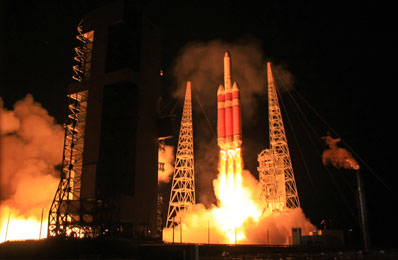

The Delta IV Heavy launch on January 17th (Chris Miller/Spaceflight Now)
[/caption]On Saturday, very little was known about the mammoth payload a Delta IV Heavy was carrying into space. Launching from Florida’s Cape Canaveral Air Force Station, the 70 metre-high rocket blasted into the atmosphere with a mystery satellite known only as the NROL-26 mission. As the acronym suggests, the mission was carrying a National Reconnaissance Office satellite. However, a little after T+7 minutes 40 seconds, shortly after the second stage engines had fired, a media blackout prevented the world from knowing where the payload was going.
Four days on from this secretive rocket launch, what do we know about NROL-26?
The Delta IV Heavy is part of Boeing’s Integrated Defense Systems division Delta IV rocket family. This monster of a launch vehicle can deliver 1.9 million pounds of thrust, carrying large payloads to geosynchronous orbit, some 22,300 miles (36,000 km) above the Earth’s surface. The Delta IV was designed with military and commercial payloads in mind.
Watching the video of Saturday’s launch, one cant help but be in awe of this rocket system. The Delta IV Heavy carried out its second fully successful flight on that day (the Delta IV Heavy first demonstration flight failed to reach the correct orbit in 2004), placing the most expensive (and most clandestine) military spacecraft into orbit. Naturally, details are rather sketchy about what the spacecraft actually is and what it is going to do, but some estimates put the total cost of the rocket plus payload at over $2 billion, so it is obviously a very important mission.
Once NROL-26 successfully reached its destination (wherever that may be), the satellite was renamed “USA 202”. We can say with some certainty that USA 202 is an advanced spy satellite of some description. According to one source, the intent of USA 202 is to act as the next generation in orbital eavesdropping technology, deploying an antenna possibly as wide as 350 feet.
According to GlobalSecurity.org (a military think-tank), USA 202 could be of an “Advanced Mentor” design. Older versions are believed to have been launched by the National Reconnaissance Office and the Central Intelligence Agency under the code name “MENTOR” from 1995 to 2003. These satellites, in geostationary orbits, collect ground-based radio emissions using very large antennae (some as wide as 100 metres). They are also thought to be very big satellites, weighing in at over five tonnes. Like USA 202, these older satellites are highly classified and there is no official word confirming or denying any of the specifications.
Last weekend’s successful Delta IV Heavy launch will come as a relief to the security services operating the top secret satellite as launches have fallen behind schedule through failures and technical challenges. These spy satellites are critical to the White House and Pentagon, as the information gathered by USA 202 aid military decisions and shape foreign policy. In this case, it is thought Saturday’s Delta IV Heavy launch will enhance the ability to intercept communications from rogue states and terrorist organizations around the planet.
Let’s hope USA 202 remains operational for its designated lifespan, as we know what happens to spy satellites that don’t behave…
Sources: Space Flight Now, Space.com, Boeing, Florida Everyone Forgot,
Dubbed CADRE, a trio of lunar rovers are set to demonstrate an autonomous exploration capability…
Astronomers have identified sulfur as a potentially crucial indicator in narrowing the search for life…
Biologists identified a series of "hard steps" on the journey from abiogenesis - that life…
The supermassive black hole at the center of our Milky Way galaxy may not be…
For those who missed the memo, UFOs (Unidentified Flying Objects) are now called UAPs (Unidentified…
The Phoenix Cluster is one of the most massive galaxy clusters known. Astronomers have identified…